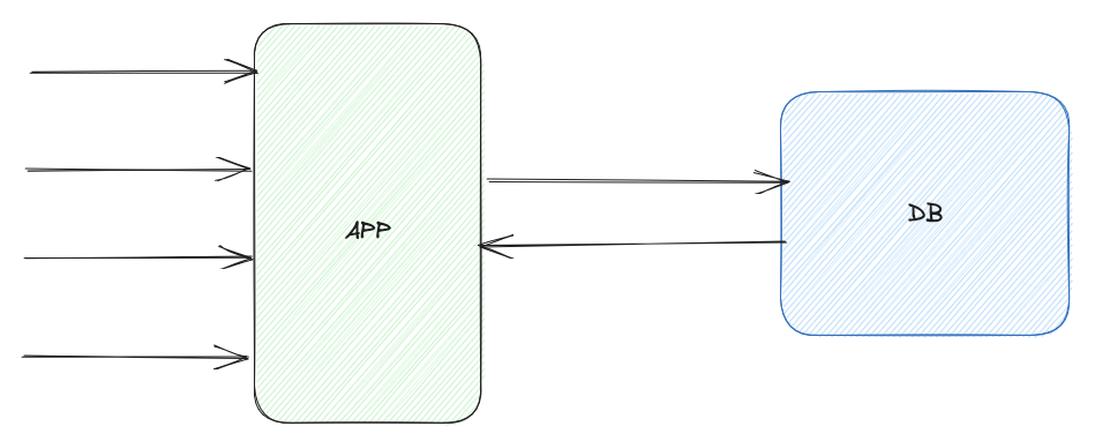
One way to architecture your Golang app
- Hugo Sjoberg
- Golang , Architecture
- September 30, 2023
One way to architecture your app
One common question/talking point in the golang community is how to architect your application. It’s a pretty loaded question and a lot of people have a strong opinion on what’s the “right” way. I don’t think that there is one way of architecture your app, that being said I will present one way of architecture your app.
There are many architectures out there such as
- Hexagonol Architecture
- Domain Driven Design
- CQRS
- And many more
Typically these design patterns do not have its roots in golang but rather stem from more traditional programming languages such as Java and C# where inheritance polymorphism and other OOP patterns is a big thing. While this kind of architecture might make sense in another programming language I don’t necessarily think it makes sense in Golang.
Project Structure
Let’s start with the basic project structure, I typically try to follow this resource as it’s pretty commonly used throughout the industry.
According to Organizing a Go module we’ll need the following:
/cmd
This will serve as the entry point to our program eg. go run /cmd/api/my-app.go, the code here should be super light, just invoke code from /internal and /pkg nothing else.
/internal
Private app and library code, this code is only to be consumed by this application/library. This is typically where most of your app code will end up.
/api
Here is where OpenAPI/Swagger files should be placed.
Makefile
Makefile to handle the commands needed to operate the project, e.g.: make lint for linting the code, make generate to run code-generators.
Generate your APIs
As a programmer I’m lazy and as I’m getting older I also want consistency. For example, it’s annoying when your OpenAPI/swagger differs from the actual implementation, so let’s generate our APIs from our OpenAPI specification.
To do this we can use a package such as OAPI-codegen or the more flexible goapi-gen . I prefer the latter since it allows to use middleware per endpoint instead of only adding middleware on the project level.
Below is an example spec for two APIs, one user endpoint to fetch the current user and one admin endpoint to create a new user.
openapi: 3.0.3
servers:
- url: 'http://localhost/v1'
components:
schemas:
Error:
type: object
properties:
code:
type: integer
format: int32
message:
type: string
User:
type: object
properties:
id:
type: string
name:
type: string
paths:
/user:
get:
description: Get's the current user
responses:
200:
description: user response
content:
application/json:
schema:
$ref: '#/components/schemas/User'
default:
description: error
content:
application/json:
schema:
$ref: '#/components/schemas/Error'
/admin/user:
post:
description: Creates a user
responses:
200:
description: Creates a user
content:
application/json:
schema:
$ref: '#/components/schemas/User'
default:
description: error
content:
application/json:
schema:
$ref: '#/components/schemas/Error'
requestBody:
required: true
content:
application/json:
schema:
type: object
properties:
name:
type: string
And a file to generate the handlers:
/internal/api/main.go
//go:generate go run github.com/discord-gophers/goapi-gen@v0.3.0 -o gen.go -package api ../../api/api.yaml
package api
Running go generate ./... will generate the interfaces for your handlers, pretty neat right? Now we just need to implement the interfaces.
Implement the interface
We can create two new packages, user and admin, and you guessed it, all code needed for the user is in the user package and all the code needed for the admin is in the admin package. When I say all code needed for the user it would be all the handlers(API), all the business logic, database interactions etc. To keep things short I will just implement a super simple handlers.
// internal/user/handler.go
type UserHandler struct{}
func (u *UserHandler) GetUser(w http.ResponseWriter, r *http.Request) *api.Response {
id := "123"
name := "John Doe"
return api.GetUserJSON200Response(api.User{ID: &id, Name: &name})
}
func NewUserHandler() *UserHandler {
return &UserHandler{}
}
// internal/admin/handler.go
type AdminHandler struct{}
func (u *AdmimHandler) PostAdminUser(w http.ResponseWriter, r *http.Request) *api.Response {
var req api.PostAdminUserJSONRequestBody
if err := render.Bind(r, &req); err != nil {
errorCode := int32(http.StatusBadRequest)
errorMessage := "Bad request"
return api.PostAdminUserJSONDefaultResponse(api.Error{Code: &errorCode, Message: &errorMessage})
}
id := "123"
return api.PostAdminUserJSON200Response(api.User{ID: &id, Name: req.Name})
}
func NewAdminHandler() *AdminHandler {
return &AdminHandler{}
}
And we can merge the Handlers together so that we implement the interface which we generated.
// server/server.go
type handlers struct {
user.UserHandler
admin.AdmimHandler
}
func newHandler() *handlers {
return &handlers{
UserHandler: *user.NewUserHandler(),
AdmimHandler: *admin.NewAdmimHandler(),
}
}
func Start() {
apiHandler := api.Handler(newHandler())
http.ListenAndServe(":8080", apiHandler)
}
Everything should run now 🤞
Conclusion
This architecture is not the most advanced architecture, as you can see there’s not much abstraction and nothing magical(Ok, the code generation is pretty magical). I also don’t think an architecture should be much more advanced than this, code is meant to be easy to read and easy to understand. The more abstractions or <insert-buzzword> design-pattern we use the harder it get’s to read, write and refactor code.
The code used in this blog post can be found here
